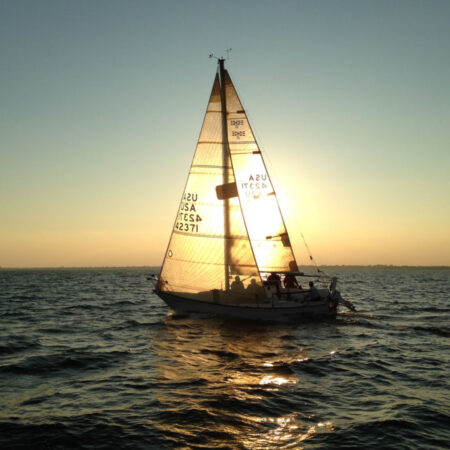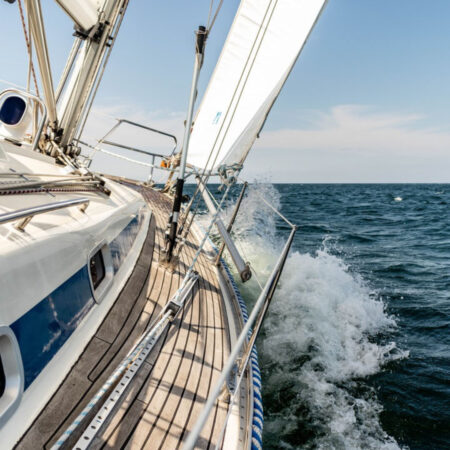First Sail
You’ve been thinking about it for awhile. Maybe a long while. But you’re a little nervous. It seems like it’d be fun, but it’s so unfamiliar. And you don’t want to seem like some kind of rube if you’re the only one on the boat who’s never gone sailing before.
But here’s the thing … it’s going to be a lot more fun than you think, and a lot less intimidating. I’m going to show you why.
I was about 20 when I took my first stab at sailing. I’d always been kind of fascinated by boats. But my family were definitely not interested in any kind of water sports. So I’d hardly ever been on a boat.
So when I found out the university where I was studying offered recreational sailing classes, I was curious, but pretty nervous about actually signing up. It took me a bit of time to work up the courage to try it out, but I’m really glad I did! Over time, sailing took hold for me and has unquestionably improved my life. You may not end up as hooked as I did, but I’m sure you’ll find going for a sail will be enjoyable. And maybe you’ll find a new favorite pastime.
So here’s what you should know to make you more comfortable, more relaxed and more likely to have a good time on your first outing.
When you get on board, the skipper — the “driver” who is in charge of the boat — will give you a personal flotation device — a life vest — to keep you safe. Safety is the most important value on a boat and the skipper may give you some other instructions or advice for safety. Sailing is not particularly dangerous, and part of the reason for that is that good sailors take care to be safe.

A couple things you’ll notice when you come on board: The boat moves a little, even at the dock. It may even tilt some as people move about. That’s normal. It’s actually kind of fun, in the way a kiddie amusement park ride is fun. When you leave the dock and put sails up, the boat may tilt a bit more, maybe even 20 or 30 degrees. That’s also normal. In fact, boat designers plan for it — the boat sails faster and more efficiently when tilted a little. So if there’s not enough wind to tilt, or “heel,” the boat properly, the skipper may ask crew members to sit where they will force the boat to heel.
As you get under way, you’ll hear the skipper and crew use some unfamiliar words. Mostly, they use this slightly bizarre vocabulary because there are things and tasks on a sailboat that don’t exist on land. So they have words for those that most people don’t use on land.
You’ll notice there are a lot of ropes on the boat. Actually, sailors don’t use the word “rope,” because the word suggests a piece of cordage that has no particular job. But every rope on a sailboat has a job — and a name. You won’t know all those names, and you won’t need to. But with a bit of instruction, you can still help sail the boat. The more you sail, the better you will learn the ropes, as sailors say.
Let’s talk a little about what makes the boat move. It’s obvious, right? The wind pushes it! …. Actually, no. The wind does NOT push the boat. The wind pulls the boat. What’s the distinction? Well, if the wind were simply pushing, it wouldn’t matter much what sails were up and how they were oriented to the wind, the wind would still push.

But you’d have a problem: You could go only one direction — the direction the wind is blowing. And you’d have to hope the wind changes direction when it’s time to come home. Since we all want to get home and have a nice dinner, sailors need another way to make things work. So instead, sailors use the sails the same way pilots use aircraft wings.
By giving them a specific shape — curved, not flat — and orienting then carefully to the oncoming wind, they create a bit of a vacuum on the top of the wing or the outside edge of the sail. That vacuum pulls the wing or sail that direction — up in the case of and airplane or forward in the case of a sailboat.
That means that in order to sail a boat, the skipper and crew need to carefully orient the sails to the wind to generate the greatest amount of what both sailors and pilots call “lift.” If you have enough lift you can fly your airplane or sail your sailboat anywhere you want to go. That’s why you’ll see skipper and crew paying a lot of attention to adjusting sails.
Most of the equipment used to do that are ropes — lines — such as the main sheet and jib sheets. The main sheet is the primary control for orienting the main sail, the big sail that’s attached to the mast. The front sail, the jib, is controlled by two jib sheets. You’ll also see crew using the main halyard, the line used to pull the mainsail up the mast, at the beginning of your trip. At the end of the trip, you’ll notice they use the jib furling line to roll up the jib to get ready to dock. Those are a few of the lines on a typical sailboat.
A few paragraphs back, I told a tiny fib. I said with enough lift, you could sail anywhere, which is essentially of true. But you may not be able to sail directly where you want to go. If your destination is directly into the wind, and you try to go straight there, your sails will flap like flags on Memorial Day and you won’t be able to generate any lift at all. So how do we get upwind?
Well, if we set our sails properly and sail carefully, we can use lift to sail obliquely into the wind — about 45º away from dead upwind. To get to our destination, we sail 45º away from dead upwind and then turn and sail to the same 45º away from dead upwind, but with the wind on the other side of the boat. That way, the boat zigs and zags back and forth, and pretty soon, we’re at our destination dead upwind.
Making those turns is called tacking, and it’s kind of exciting. You’ll hear the skipper say “Prepare to tack,” and crew members responding, “ready.” Then the skipper begins to turn the the boat into the wind. The sails start to flap and make a lot of noise. Someone will release one of the jib sheets from where it was secured. As the boat continues to turn and veer away from the wind, someone else will then pull in the other jib sheet and secure it.
After the boat has turned about 90º, the sails fill with wind and quiet down, and you’ll set off in your new direction. During that process, the boat, which was tilted one way, will come upright briefly and then tilt the other way under the influence of the wind. Crew members who may have been sitting on one side may switch to the other side, both to help balance the boat and to be more comfortable.
The details of that maneuver differ from boat to boat, and from one crew and skipper to another, but the essentials are the same for all sailboats from the smallest pram to the largest square rigger.
Some other things that vary from one boat to another: How it’s steered — some use a tiller (essentially a stick attached to the rudder), others use a wheel. Some boats have winches — devices to help pull and retain lines — others don’t. Some boats have lots of electronics to help the skipper and crew navigate. Others have little or no such equipment.
Those are some of the basic things to expect on your first sailing trip. It’ll be an experience unlike most anything you’ve ever done. So you’ll need to bring all your flexibility and openness to new things. But mostly, bring your sense of adventure and fun.
If you want to prepare a bit for your first sail, here are some of the things sailors do:
- Practice noting what direction the wind is blowing. When you’re outside, turn your face so you feel the breeze on both cheeks. When you do, you’re looking straight into the wind. That’s one way to ascertain the wind direction. Developing a good wind sense is important because sailors need to know what direction the wind is blowing to be able adjust the sails correctly.
- Bone up on good balance. The boat is constantly moving, so when you’re standing up on board, you’ll need to keep your balance. Most sailors get used to always holding onto something when standing. The saying is “one hand for the boat, one hand for yourself.” You can play with maintaining your balance by trying to walk just along the cracks of a sidewalk, say.
When you reach the decision to come out for a sail, all you need to bring is a hat and sunscreen to protect you from the sun, perhaps a bottle of water, and a jacket in case it gets cool.
I hope this has eliminated some of the mystery for you if you’ve been pondering going for a sail. The next step is to contact Spinnaker Sailing to get on a boat. No experience is necessary. Once that’s done all you have to do is show up, which, according to the quote, is 80 percent of life. And showing up to go sailing is a lot of fun. It could even be life-changing.



